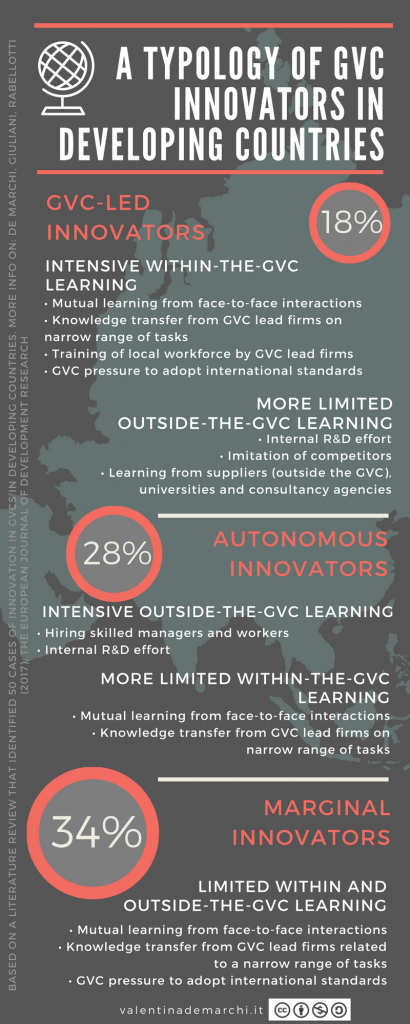Do Global Value Chains offer Developing Countries Learning and Innovation Opportunities?

The role of developing countries in the global economy via embeddedness in Global Value Chains (GVC) is increasing, but their ability to become innovation leaders is less certain, write Valentina De Marchi, Elisa Giuliani and Roberta Rabellotti. Our analysis on GVCs in developing countries shows three dominant types of innovators within the GVC who display various levels of innovativeness and use different learning mechanisms. Results suggest that GVCs are not as powerful as expected to promote innovative processes in developing countries.
Global Value Chain and Innovation
Participation in Global Value Chains (GVCs) has been recognised as providing an important opportunity for developing countries to access and acquire foreign knowledge. Inter-firm linkages within GVCs are considered key channels for transferring knowledge and promoting innovation [1]. The building of the local capabilities required to introduce new products and processes and to perform more complex tasks does depend on the patterns of governance and power relations ruling the links between local suppliers and GVC lead firms, which orchestrate the value chain at a global level [2] [3]. But innovation in firms involved in GVCs is also influenced by internal or intra-firm sources of learning [4] as well as by external links to other organisations in the national and local innovation systems [5]. Local GVC suppliers differ in their capacity to absorb, master and adapt knowledge and capabilities that lead firms potentially can transfer to them. They differ also in their openness to other sources of knowledge outside the GVC and in their embeddedness in more or less advanced and mature local innovation systems.
Do firms involved in GVCs innovate?
In a recent paper, based on a review of 50 GVCs cases in developing countries, we have codified information about (a) different forms of innovation taking place at the local level distinguishing among product, process, organisational and market-related inventions, and the degree of novelty (new-to-the-world, new-to-the-country, new-to-the-firm); (b) different types of learning mechanisms within and outside GVCs, and then performed a cluster analysis developing a typology of local GVC innovators, representative of different industries and countries.
Figure 1 summarises the characteristics of the three types of GVC innovators. Overall, just under a fifth (18%) of the cases fall into the GVC-led innovators group, while a third (28%) are what we call Autonomous Innovators and more than half (54%) of the cases analysed fall into the Marginal Innovators group. Since our cluster analysis is based on empirical evidence from studies of GVCs and innovation, these results are somewhat surprising, as we would have expected these studies to report a more relevant role of GVC lead companies in local innovation.

GVC-led Innovators are characterised by high levels of innovativeness and use of all possible learning channels within the GVC – particularly, face-to-face interactions and lead firms’ provision of training for local personnel. In some cases, innovation is induced by the need to comply with the strict production standards imposed by lead firms, which often is achieved thanks to extra-GVC learning. In addition to intensive use of learning channels within the GVC, innovation activities benefit from links to other local non-GVC actors (e.g. suppliers, universities, business associations) and imitation of proximate actors. An exemplary case in this group is the coffee GVC in Brazil [6] which is characterised by a virtuous learning system led by Illycaffé together with some local business associations and universities. Through incentives to innovate and provisions of direct technical assistance, Illycaffé supports the introduction of process and product innovations required for entry to the global high-quality coffee market. Business associations, such as the Brazilian Specialty Coffee Association (BSCA) and the Council of Coffee Growers’ Associations of the Cerrado Region (CACCER), also support local innovation efforts through the provision of technical training, knowledge transfer, joint marketing initiatives and promotion of scientific research programmes in partnership with local research institutions. Supported by a favourable local innovation system and stimulated by their involvement in the GVC, local firms invest in innovation. One example is Daterra, a local Brazilian company and, initially, exclusive supplier to Illycaffé. Based on investment in an internal laboratory to enable quality analysis, and development of a traceability system to map quality, Daterra now sells mainly through its own chain in the global market, with only a small proportion of its total production going to Illycaffe.
Autonomous Innovators’ use of knowledge for innovation via GVC channels is limited, they mainly receive knowledge from the lead firm for undertaking a small range of tasks and/or have face-to-face interactions with the managers in the lead firms. These innovative firms do not exploit other GVC learning channels and rely almost entirely on internal R&D to sustain their innovative efforts, acquiring knowledge from hiring skilled employees (often returnees or expats) and via equity-agreements (acquisitions, joint ventures, licensing). In many cases, these kinds of arrangements are considered the most relevant, since they enable rapid and effective innovation. The Chinese wind turbine industry developments [7] exemplify this type of firm. Initially, the Chinese wind industry was driven by the domestic market and most of the technology was imported from European producers, which established local turbine manufacturing subsidiaries in China. Much of their success was from tapping into the established design and engineering capabilities of overseas firms and acquiring knowledge via technology licensing with European companies. More recently, Chinese wind companies have been investing in large R&D departments in China as well as in Denmark and Germany – the leading wind industry countries.
Finally, Marginal Innovators include GVCs in which local firms have mainly introduced only new-to-the-firm processes, organisational or product innovations. They do not perform in-house R&D and the weakness of their local innovation system does not encourage use of local learning sources. Besides, they only rely on GVC knowledge to a limited extent. The numerous cases characterised by weak innovation include the clothing industries in Kenya and Madagascar. Here, local firms receive some technical assistance from buyers [8], but this results in very little product and process innovation with the result that, Kenyan companies, in particular, are locked into GVCs serving the US market in the high-volume commodity segment, while companies from Madagascar involved in GVCs targeting the European or the South African markets seem to engage in more process and product upgrading. This is explained by the different characteristics of the destination markets, such as demand for small batches requiring more flexibility, which fosters process innovation capabilities and design independence.
Implications
In essence, scholarship is telling us that GVCs are not as powerful as we had expected to promote innovative processes in developing countries. Overall, firms in developing countries that operate in connection to GVCs resort to other learning sources to sustain their innovative efforts, or they do not innovate at all, in spite of their global connections. We feel that if these results would be further corroborated by more empirical research, this could have important implications for policy: GVC will not fix the internal weaknesses in developing countries’ institutions, and therefore developing countries should invest in their own capability-building institutional apparatus, encouraging and promoting firm-level learning via targeted innovation policy interventions.
This post first appeared on the LSE's Global Investments and Local Development blog. It s based on the article ‘Do Global Value Chains Offer Developing Countries Learning and Innovation Opportunities?’ by Valentina De Marchi, Elisa Giuliani, and Roberta Rabellotti, published in The European Journal of Development Research, 2017. This post represents the views of the authors and not those of the GILD blog, nor the LSE.
Valentina De Marchi is an Assistant Professor in the Department of Economics and Management “Marco Fanno” at the University of Padova.
Elisa Giuliani is a Professor in the Department of Economics and Management at the University of Pisa, and a Visiting Professor at MIT Sloan School of Management.
Roberta Rabellotti is a Professor of Economics in the Department of Political and Social Sciences at the University of Pavia, and an Assigned Professor at the University of Aalborg associated with the IKE (Innovation, Knowledge and Economic Dynamics) Research Group.
Image credit: Boegh via Flickr (CC BY-SA 2.0)


